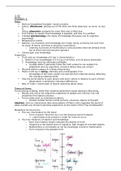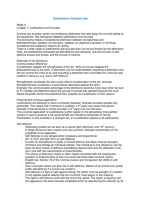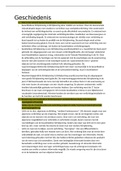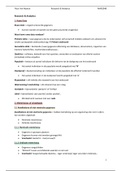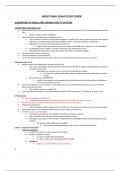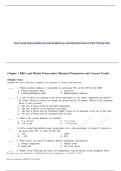Problem 1
Plato
Built on/ broadened Socrates’ moral concerns
Justice: dikaiosune- getting out of life what one fairly deserved, no more, no less
&
Virtue: pleonexia- grasping for more than one is fairly due
First thinker to inquire how knowledge is possible, and how it’s justified
Created epistemology- the study of knowledge that gave rise to cognitive
psychology
Metaphysical realist
Nativist- our character and knowledge are innate, being carried by the soul from
its vision of forms, and lives in previous incarnations
o Learning is process of recollecting to consciousness what we already know
but of which we have become ignorant
Cannot gain true knowledge
Scepticism
Truth and our knowledge of it has 2 characteristics:
1. Belief is True (knowledge) if it is true in all times, and all places absolutely
2. Knowledge must be rationally justifiable
A judge doesn’t genuinely know the truth unless he can explain his
judgments and, by argument, convince others they are correct
Physical world is always in a state of becoming
Plato’s truth lay in being- eternally and unchangeably True
o Knowledge of the truth couldn’t be derived from material senses reflecting
the changing material world
How the world seems to each person and each culture is relative to each of them
o Observation is tainted by individual differences
Way of Truth= inward path of logical reasoning about ideas
Theory of Forms
Forms belong to Being, while their material ephemeral copies belong to Becoming
Beauty and virtue not subjective judgments of people and cultures, but real
properties that objects possess
Forms really exist as nonphysical objects
o Existed outside human minds as fixed, universal, objects of thought
Idealism- term to characterise later descendants of Plato’s who regarded the world of
ideas outside any human’s personal experience as the realm of the True and Beautiful
Metaphors for the Forms:
1. The sun: Illumination by the Good
o Form of good= what the sun is to the physical world of objects
Light needs to be present in order for vision to occur
2. The line: Hierarchy of Opinion and Knowledge
o Each lines relative length indicates the degree of truth
o Imagining is the lowest level of cognitive, with images of concrete objects
o Mathematics is incomplete as not all knowledge concerns mathematics
o Form of good is the greatest form
, 3. Allegory of the Cave: Prison of Culture
o Their only reality is the shadow cast on the wall
o If a prisoner is set free, made to look towards the firelight
Hard for the liberated prisoner to give up familiar reality for greater
reality of fire and statues
Must be dragged through the pain, past the fire at the mouth of the
cave, and into the world that the sun illuminates
o Finally liberated prisoner would look back on old life with distain
Each human soul is imprisoned in imperfect, fleshly body, forced to
look through imperfect physical eyes at imperfect copies of forms,
illuminated by the sun
The soul is victim to conventional beliefs of the society it lives in
Should turn our souls around from ordinary world/ cultural
presuppositions, and undertake journey to the better world of Forms
and the reality of what objects are
4. Ladder of Love: Being Drawn to the Good
o Describes the love of Beauty
o The easiest path from this world to
Forms
o Upward ascent from profane physical
love to sacred love of Form of Beauty
o Rung 1= sexual love, should be steered
in right direction by philosophical guide
o Rung 2= lover of all bodies relaxes
vehemence for run one, look down on it
believe it of small importance
o Rung 3= Beauty in souls is more valued
than in the body
o Rung 4= Beauty is Truth and Truth is
Beauty
Knowledge Within Us
Souls go through cycle of reincarnation
Born in heaven, and see forms before first incarnation
Future fate of soul depends on how virtuous life on earth was
Wicked come back as beasts: virtuous ascend to highest reaches of heavens and
see forms again
o Less virtuous ascend less high in heaven and quickly reincarnated as
lesser humans
Knowledge of virtue is latent in the soul, hidden by the body and conventional
belief, awaiting right stimuli to be recollected
Memory is reminiscence of absolute Truth from soul’s passage through the
heavens, between incarnations
Motivation
, Happiness and virtue are intimately connected, and people naturally seek
happiness
Three forms of soul present in each human being, parallel to three citizen classes:
o Class membership determined by while soul rules each citizen
Rational soul- the highest and only immortal soul, located in the head: rules
each Guardian, who are most fit to rule the republic
In the head as it is perfect so must be in roundest and highest part of the
body
Spirited soul- the second-best soul, located in the chest and dominant in the
Auxiliaries, motivated by fame and glory, can feel shame and guilt
Desiring soul- worse soul, located in the belly and genitals, irrational wants
and pursuit of self-interest
Human personality is a chariot pulled by two horses:
o First horse= spirited soul
o Second horse= desiring soul
o Charioteer= rational soul- should master the horses and drive them toward
the good
Mastering desiring soul is nearly impossible
o Even when rational soul thinks it’s master, desire springs up in
dreams
Bad behaviour may stem from insufficient mastery of the rational over the spirited
and desiring souls
Worse sins are committed by giving in to demands
Evaluation
Constructs first general point of view in philosophy
Ideas resonate with other religions
In description of human personality, reason is sharply differentiated from
irrational passion
Difficulty in relationship between reason on one hand and emotion/motivation on
the other
o Hume- emotion, reason is and can only be a slave to passions, capable of
steering them but not initiating action on its own
o Freud- agreed & described rational ego as a rider struggle to master the
horse of the id, Plato’s desiring soul
o Pascal- heart has its reasons, that reason does not understand
Charioteer image explaining behaviour of a person by putting small person
inside= not adequate, as actions of inner person remain unexplained, violating
Iron Law of Explanation
Aristotle
Concerned with discovering what is natural (then called, natural philosophers,
now called scientist)
Believed human way of life should be built on what was best for human nature
Perceptual realist
True knowledge can be gained through experience
Empiricist
Four Fashions of Explanation
Four ways to explain things- focuses on understanding what a thing is
Most basic conceptual division between form and matter
o Matter- sheer, undifferentiated physical existence
for matter to be knowable, has to be joined to form
o form- what makes a thing that which it is, defining it, and making it
intelligible to us
Aristotle= form, Plato= Form
Comprised of other 3 causes:
1. Essential cause- what something is in its essence, definition
2. Efficient cause- how things come into existence or are made
3. Final cause- the purpose for which a thing exists
, Is independence of physical embodiment, but doesn’t exist
separately from it, without being physically embodied in a type of
matter
Eg. matter of a statue is what it’s made of form is what it is
Mind receives the form of an object but not its matter
The alleged eternal Forms explain nothing
Aristotle observed nature and offered accounts of how it works
o Efficient causes were impositions of humans on nature (eg. without
humans an oak tree won’t become a table)
Causes are the natural behaviour of things given their essences eg.
apple falls off tree because that’s it’s essence
Efficient causes are unimportant to study nature, being part of the
human world of purposes and actions
Potentiality and Actuality
Everything in the universe has both potentiality and actuality
Two exceptions:
1. Pure matter
2. Unmoved mover
o Sheer matter without form of any kind= pure potentiality, capable of
becoming anything: if there’s pure potentiality must be pure actuality
Unmoved mover- a being whose potentiality is used up, incapable
of further changed, perfected
Moves by being desired, not through activity of its own
Natural scale (Great Chain of Being)- Striving for actualisation creates grand
hierarchy among all things, from perfectly unformed neutral matter in pure
potentially, to the unmoved mover
Soul and Body
Psychology is the study of the soul
All living things possess soul as their form, it’s a living things’ soul that defines its
nature
Soul is the essential, efficient, and final cause of an organism
o Essential cause= defines an animal or plant as it’s the
o Efficient cause= bodily growth, movement, and life processes
Without soul, body not actualised and dead (matter)
o Final cause= body serves the soul, and the soul guides its purposive
development and activity
Rejected separability of soul and body
All living things have soul, but different forms of living things possessing different
forms
o Three levels of soul appropriate to different levels of actualisation:
1. (Lowest level) nutritive soul- possessed by plants, serving three
functions 1) maintaining individual plant through nutrition 2) maintaining
species through reproduction 3) directing growth
2. Sensitive soul- possessed by animals, subsumes the nutritive soul’s
functions while adding others, making it fully actualised
Aware of surroundings, experience pleasure and pain, so feel desire to seek
pleasure or avoid pain
o Creates a) imagination and memory b) movement because
of desire

